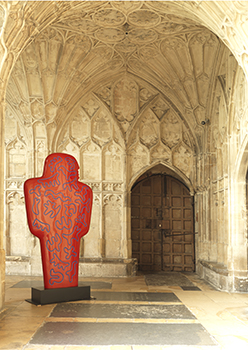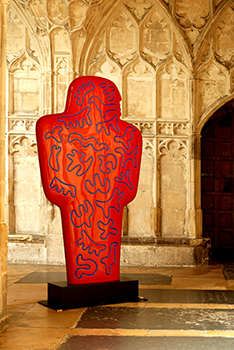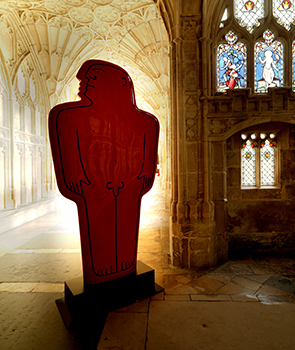Public Art
Crucible 2
Gloucester Cathedral
Ist September – 31st October 2014
This second exhibition of public sculpture in Gloucester Cathedral follows the hugely successful show, ‘Crucible 2010’. It was the largest exhibition of public art to be seen in the cathedral in modern times, consisting of over seventy contemporary sculptures which were seen by more than a hundred and thirty-six thousand visitors over two months. Both exhibitions highlight just how contemporary sculpture can benefit from being taken out of the conventional setting of the gallery space. Placing them in this historic setting changes the audience’s perception of both the art and the space itself, the very ideal to which public art aspires.
Like most of England’s medieval cathedrals, over its long life Gloucester has contained and exhibited some of the most beautiful examples of public art ever produced by English artists and craftsmen. Sadly over time the Church’s turbulent history has meant that many of these works no longer exist. It is exciting therefore to see the empty spaces once again, albeit only for a short while, filled with thought-provoking public art. This new exhibition, ‘Crucible 2’, expands and develops the achievements of that first show by placing one hundred sculptures by sixty-one artists within the confines of the cathedral and its grounds.
I personally was asked to contribute five sculptures to this great festival of contemporary public art: ‘In Man’s Nature’, ‘Underdog, ‘Longdog’, ‘Bombird’ and ‘Midnight Movie Heads’. Some of these, such as ‘In Man’s Nature’ and ‘Longdog’, were always conceived as pieces of public art but others of a more intimate nature also unexpectedly benefited from the cathedral’s benign and beautiful architectural spaces. ‘In Man’s Nature’,the largest of the five sculptures, was not only the most appropriate of my work to be exhibited but also to my mind had the most impact, shown against the backdrop of the medieval architecture.
The startling red colour is a major part of this sculpture’s appeal and its vibrant colour and stripped-down form made a huge impact in this historic setting, yet the drawn elements of the common man and his collection of animal motifs and symbols found a close affinity with some of the cathedral’s own medieval carving and architecture. The sculpture as a whole is totemic; nature is both within us and outside us and it is these elements that made it a widely accessible contribution to this enormously successful festival of public art.



